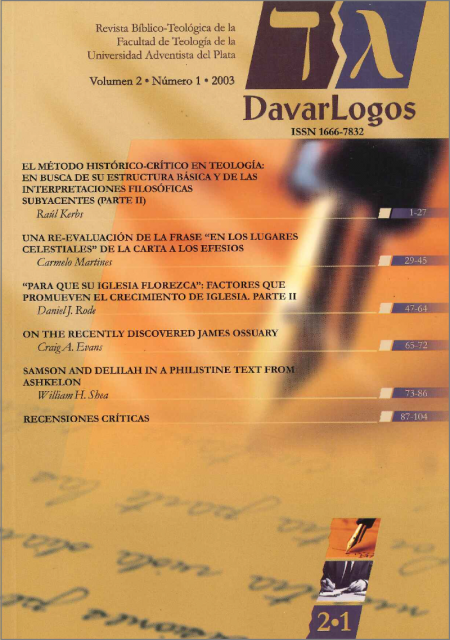SAMSON AND DELILAH IN A PHILISTINE TEXT FROM ASHKELON
Resumen
Un ostracon filisteo se encontró en la excavación de un edificio de tipo comercial en la ciudad filistea de Escalón. El edificio fue destruido por los ejércitos de Nabucodonosor de Babilonia en 604 aC. El ostracon pertenece a este nivel de destrucción. Como se interpreta en este estudio la cerámica representa un despacho diplomático del rey de Escalón al rey de Gaza. Trata de la mudanza de la cabeza del hebreo Sansón. Por lo tanto, cuando Sansón murió en la destrucción del templo de Gaza, se cortó su cabeza antes que se mandó su cadáver de vuelta a Israel. Se preservó como un trofeo o un talismán mágico representando la victoria de los filisteos sobre sus enemigos. La decapitación también ocurre en el caso de Goliat y en los casos de Saúl y Jonatan, al ser derrotado en la batalla por los filisteos. El texto también menciona los nombres de tres reyes filisteos de la última parte del séptimo siglo aC.
Abstract
A Philistine ostracon was found during the excavation of a commercial-type building at Ashkelon. The building was destroyed by the army of Nebuchadnezzar of Babylonian in 604 BCE. The ostracon belongs to this destruction level. As interpreted in this study, the text on the sherd is a diplomatic dispatch or letter from the king of Ashkelon to the king of Gaza. It deals with the movement of the head of Samson the Hebrew. When Samson died in the destruction of the temple of Gaza, therefore, his head was cut off before his body was taken back to Israel. It was preserved as a trophy or magic talisman representing the Philistine defeat of their enemies. Decapitation also occurred in the case of Goliath and in the cases of Saul and Jonathan when they were defeated on the battlefield by the Philistines. The text also includes the names of three Phil-istine kings of the late seventh century BCE.





